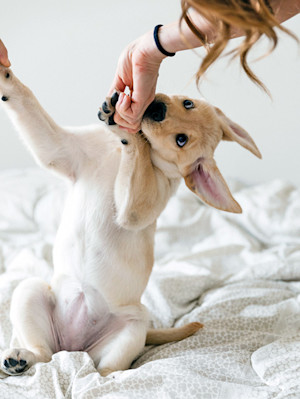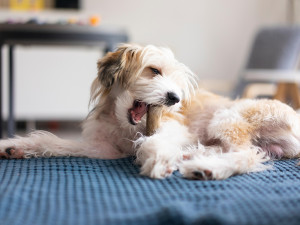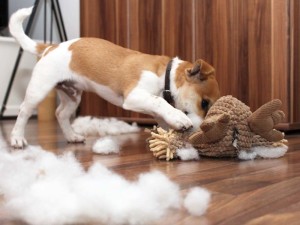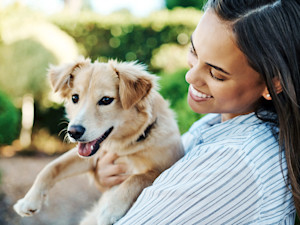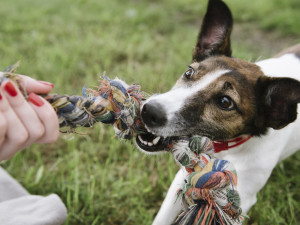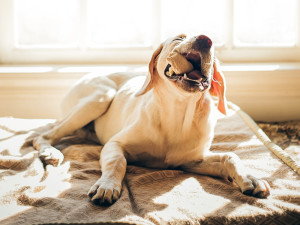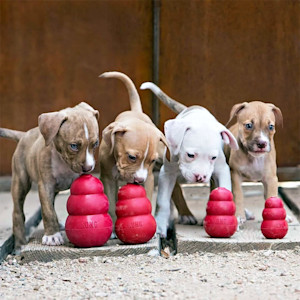Should I Give My Dog Antler Dog Chews?
There are some safety concerns you need to know.

Share Article
In This Article:
Can Dogs Chew on Deer Antlers? Are Antler Chews for Dogs Safe? Are Antler Dog Chews Safe for Puppies? Alternatives to Antler Dog Chews
Walking into the treat aisle at the pet store can be overwhelming. There are a million different types of treats available, your dog is excited about all of them, and they all claim to be the tastiest, healthiest, awesomest treats in existence.
One of the many products available are dog antler chews. They seem hard as a rock, but many claim to be great for dogs’ teeth. But are antlers safe for dogs?
Can dogs chew on deer antlers?
Some of the most common questions on internet message boards and forums for pet parents are about appropriate treats for their dogs. Posts that look like this show some of the confusion around antler chews for dogs: “I’m a little unsure about something and hoping for some advice. My dog loves to chew, and I've been thinking about getting him a deer antler. I’ve heard they can be good for his teeth, but I}ve also heard they can splinter and cause problems. Has anyone had experience with giving their dog antlers? I just want to make sure it’s a safe treat for him.”

Unfortunately, antlers aren’t an appropriate treat for dogs. Although dog antler chews have some positive aspects — they’re natural products and are often minimally processed — the truth is that they’re just too hard for dogs to chew on. Dogs love to gnaw on things, often to their detriment. While a deer antler can provide hours of entertainment, it can also cause problems.
Are antler chews for dogs safe?
Some pet parents swear by deer antler treats because they’re a long-lasting treat that dogs enjoy and they claim to help remove dental tartar by mechanically chipping it away as dogs chew. The problems with deer and elk antler dog chews are that they’re long-lasting because they’re basically solid bone that male deer grow to bludgeon their competitors with. They’re developed to withstand incredible amounts of force during battles over territory or mates. Even the teeth of giant breed dogs are no match for antler chews.
When thinking about treats and chews for dogs, I recommend following the Knee Cap Rule opens in new tab promoted by Dr. Fraser Hale, a veterinary dentist: if you wouldn’t want me to hit you on your knee cap with it, don’t give it to your dog. The variation for smaller dogs is: if your dog wouldn’t want me to hit them on the knee cap with it, don’t feed it to them. Basically, anything that’s solid enough to hurt is too solid to chew on.
There are some additional questions to consider when thinking about dog chews:
Does it bend or break easily?
Would you be willing to chew on something like that yourself (excluding flavor)?
Does it splinter when broken?
So, are deer antlers safe for dogs? The answer is a resounding no. Deer antler dog chews fail on all aspects of safety (well, maybe you’d chew on one, I don’t know your life). The biggest concern with deer antlers is that they can cause slab fractures of teethopens in new tab. The same chewing action that’s supposed to break tartar off of teeth can break the teeth themselves.
Tooth fractures are incredibly painful and can result in infections of the tooth root, deep below the gumline. Dental fractures caused by chewing on things like antlers require significant dental care, requiring either a root canal or removal of the tooth entirely.
In addition to the risks to teeth from gnawing on antler chews, dogs can have other problems if they manage to break off a chunk. Swallowing chunks of deer or elk antler chews can cause problems like:
Oral infections: Rough or splintered pieces of deer antler can cause lacerations in the mouth. Most oral wounds heal quickly, but some can become infected and require antibiotics or surgical repair.
Choking: Irregular pieces of bone are notorious for getting stuck when they’re swallowed. This can cause an airway obstruction if the piece is in the throat or an esophageal obstruction that places pressure on the trachea if it’s stuck in the neck or chest.
Intestinal obstruction: Bony material is a common culprit for causing intestinal blockages. Because bone isn’t easily digested, obstructions can be caused by large chunks of bone or antler that get stuck in the small intestines. It can also be caused by sand-like bone debris that causes constipation by turning into cement in the colon.
Gastrointestinal upset: Even if the bony material is able to pass through, it can cause significant irritation to the intestines as it moves through them. This can result in vomiting and diarrhea, often bloody.
Are antler dog chews safe for puppies?
Puppies are voracious chewers and require constant entertainment when they’re not sleeping. It can be tempting to give a deer antler dog chew to a puppy as a way to keep them occupied for a while, especially when they’re teething. Deer antler chews are even more dangerous for puppies because their teeth are more susceptible to fractures. Puppies are also less likely to know their limits when swallowing something, so any broken pieces pose a more serious choking risk.
Antler chews join the wide range of other solid chews that are not appropriate for puppies and adult dogs. Avoiding giving products like these can help to protect your puppy’s teeth from injury:
Nylon bones
Cooked bones
Dried cow hooves
Dried pigs’ ears
Yak milk chews
Alternatives to antler dog chews
Now that I’ve Fun Policed away most of your dog’s favorite options, what is a good chew for dogs? In my experience, if you’re looking for products that help prevent plaque and tartar buildup, there’s no better place to start than the VOHC websiteopens in new tab. The VOHC is made up of veterinary dentists and scientists who review studies of oral health products for efficacy and safety. Their list of accepted products is a good starting point for safe, effective oral health care for your adult dog or puppy.
If you’re looking for a way to occupy your busybody dog for a while, you can consider rope toys, natural rubber chew toys (often touted as indestructible, though some determined dogs have different ideas), cloth toys, and food puzzles. Dogs should always be supervised when playing with toys because you need to be there to remove them if they begin to shred them. Getting a variety of types of toys and varying how you play with them day to day can be a great way to provide enrichment and entertainment.
Bottom line
Finding the right chew for your dog can be tough. There are a lot of products out there, and many of them aren’t as safe for dogs’ teeth as you’d hope. It’s best to stick to chews that are pliable and not brittle when broken.
You can work with your vet to find appropriate toys and chews to keep your dog occupied and help keep their teeth clean without risking injury. Even though your dog may act totally cool about not destroying things, it’s always best to keep an eye on them when they have a toy or chew so you can prevent problems from occurring.
References
Bellows, Jan. “Practical Dental Care Tips for Dogs and Catsopens in new tab.” Veterinary Partner. February 15, 2024.
Gallagher, Lindsay. “The Effect of Dental Products and Natural Chews on Canine Oral Bacteria.” Letters in General Microbiology. 2014.
Hale, Fraser. “The Kneecap Ruleopens in new tab.” Haleveterinaryclinic.ca, 2024, www.haleveterinaryclinic.ca/site/educational-material-veterinary-guelph/2024/03/18/the-knee-cap-rule-endodontics. Accessed 18 Feb. 2025.
Lewis, John. “Treatment Options for Carnassial Tooth Fractures in Dogs.” Veterinary Practice News, 22 Sept. 2021, www.veterinarypracticenews.com/treatment-options-for-carnassial-tooth-fractures-in-dogs/opens in new tab. Accessed 14 May 2025.
Paul Pion, D. V. M., and Gina Spadafori. “Veterinary Partneropens in new tab.” VIN.com, 8 Aug. 2017, veterinarypartner.vin.com/default.aspx?pid=19239&id=11934338.
Veterinary Oral Health Council. “VOHC Accepted Productsopens in new tab.” https://vohc.org/accepted-products/ Accessed 18 Feb. 2025.

Dr. Bartley Harrison, DVM
Dr. Bartley Harrison is a veterinarian with more than 19 years of experience. He has treated a variety of species in emergency and speciality practices for both large and small animals. His primary interests as a vet are emergency medicine and critical care.
Related articles
![Dog lying on blanket, chewing on a bone]()
Long-Lasting Chew Toys Are Key to Keeping Solo Dogs Happy
New research shows that chewing (toys, not shoes) reduces stress in dogs left home alone.
![White and brown puppy destroyed a stuffed toy]()
How to Stop Your Dog From Ripping Up Their Toys
How to teach your dog to enjoy, not destroy, their toys.
![woman snuggling puppy while holding them]()
Can Puppies Have Bones?
And how to keep them safe while they chew.
![A dog tugging on a toy outside]()
The Definitive Guide to Choosing Safe Dog Toys
Tips for pet parents who want their pups to have safe fun.
![Golden Retriever dog chewing on rawhide toy seated on a blanket by a window]()
Rawhide Is a Raw Deal
The six dangers of rawhide dog bones.
![four puppies teeth on red Kongs]()
Best Teething Puppy Toys of 2025: Chews, Treats and More
Because your favorite chair is not a chew toy.


